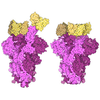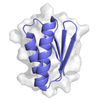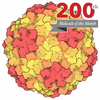[English] 日本語
 Yorodumi
Yorodumi- PDB-9cjz: CryoEM structure of NC99 hemagglutinin trimer in complex with Fab... -
+ Open data
Open data
- Basic information
Basic information
| Entry | Database: PDB / ID: 9cjz | ||||||
|---|---|---|---|---|---|---|---|
| Title | CryoEM structure of NC99 hemagglutinin trimer in complex with Fab T009 3-E04 | ||||||
 Components Components |
| ||||||
 Keywords Keywords | VIRAL PROTEIN / Immune system / Hemagglutinin / Fab / Macaque | ||||||
| Function / homology |  Function and homology information Function and homology informationviral budding from plasma membrane / clathrin-dependent endocytosis of virus by host cell / host cell surface receptor binding / fusion of virus membrane with host plasma membrane / fusion of virus membrane with host endosome membrane / viral envelope / virion attachment to host cell / host cell plasma membrane / virion membrane / membrane Similarity search - Function | ||||||
| Biological species |   Influenza A virus Influenza A virus | ||||||
| Method | ELECTRON MICROSCOPY / single particle reconstruction / cryo EM / Resolution: 3.8 Å | ||||||
 Authors Authors | Li, N. / Tsybovsky, Y. / Sangesland, M. / Kanekiyo, M. | ||||||
| Funding support |  United States, 1items United States, 1items
| ||||||
 Citation Citation |  Journal: bioRxiv / Year: 2025 Journal: bioRxiv / Year: 2025Title: Functional, Immunogenetic, and Structural Convergence in Influenza Immunity between Humans and Macaques. Authors: Maya Sangesland / Ning Li / Yaroslav Tsybovsky / Megan D Rodgers / Julianna Han / Alesandra J Rodriguez / James A Ferguson / Amy R Henry / Sarah C Smith / Jesmine Roberts-Torres / Rebecca A ...Authors: Maya Sangesland / Ning Li / Yaroslav Tsybovsky / Megan D Rodgers / Julianna Han / Alesandra J Rodriguez / James A Ferguson / Amy R Henry / Sarah C Smith / Jesmine Roberts-Torres / Rebecca A Gillespie / Cuiping Liu / Jonah S Merriam / Tyler Stephens / Connor Williams / Emma Maestle / Martin Corcoran / Michelle Ravichandran / Adrian Creanga / Sarah F Andrews / Theodore C Pierson / Gunilla B Karlsson Hedestam / Chaim A Schramm / Douglas S Reed / Daniel C Douek / Tongqing Zhou / Andrew B Ward / Masaru Kanekiyo Abstract: Human B cell immunity to the influenza hemagglutinin (HA) stem region, a universal influenza vaccine target, is often stereotyped and immunogenetically restricted, posing challenges for study outside ...Human B cell immunity to the influenza hemagglutinin (HA) stem region, a universal influenza vaccine target, is often stereotyped and immunogenetically restricted, posing challenges for study outside humans. Here, we show that macaques vaccinated with a HA stem immunogen elicit human-like public B cell lineages targeting two major conserved sites of vulnerability, the central stem and anchor epitopes. Central stem antibodies were predominantly derived from V 1-138, the macaque homolog of human V 1-69, a V -gene preferentially used in human central stem broadly neutralizing antibodies (bnAbs). Similarly, macaques produced anchor bnAbs with the human-like NWP motif. Both bnAb lineages were functionally and structurally analogous to their human counterparts, with recognition mediated largely by germline-encoded motifs. Thus the macaque immunoglobulin repertoire supports human-like public bnAb responses to influenza HA. Moreover, this underscores the utility of homologous germline-encoded immunity, suggesting that immune repertoires of macaques and humans may have been similarly shaped during evolution. HIGHLIGHTS: Functional human-like public antibody lineages can be elicited to HA stem supersites in macaques. Macaque central stem bnAbs are predominantly derived from V 1-138, a V -gene homologous ...HIGHLIGHTS: Functional human-like public antibody lineages can be elicited to HA stem supersites in macaques. Macaque central stem bnAbs are predominantly derived from V 1-138, a V -gene homologous to human V 1-69. The human-like CDR L3 NWP anchor epitope-targeting lineage can be elicited in macaques.Central stem and anchor bnAbs from humans and macaques engage their respective epitopes with atomic level similarity. | ||||||
| History |
|
- Structure visualization
Structure visualization
| Structure viewer | Molecule:  Molmil Molmil Jmol/JSmol Jmol/JSmol |
|---|
- Downloads & links
Downloads & links
- Download
Download
| PDBx/mmCIF format |  9cjz.cif.gz 9cjz.cif.gz | 348 KB | Display |  PDBx/mmCIF format PDBx/mmCIF format |
|---|---|---|---|---|
| PDB format |  pdb9cjz.ent.gz pdb9cjz.ent.gz | 282.6 KB | Display |  PDB format PDB format |
| PDBx/mmJSON format |  9cjz.json.gz 9cjz.json.gz | Tree view |  PDBx/mmJSON format PDBx/mmJSON format | |
| Others |  Other downloads Other downloads |
-Validation report
| Summary document |  9cjz_validation.pdf.gz 9cjz_validation.pdf.gz | 1.2 MB | Display |  wwPDB validaton report wwPDB validaton report |
|---|---|---|---|---|
| Full document |  9cjz_full_validation.pdf.gz 9cjz_full_validation.pdf.gz | 1.3 MB | Display | |
| Data in XML |  9cjz_validation.xml.gz 9cjz_validation.xml.gz | 66.4 KB | Display | |
| Data in CIF |  9cjz_validation.cif.gz 9cjz_validation.cif.gz | 100.3 KB | Display | |
| Arichive directory |  https://data.pdbj.org/pub/pdb/validation_reports/cj/9cjz https://data.pdbj.org/pub/pdb/validation_reports/cj/9cjz ftp://data.pdbj.org/pub/pdb/validation_reports/cj/9cjz ftp://data.pdbj.org/pub/pdb/validation_reports/cj/9cjz | HTTPS FTP |
-Related structure data
| Related structure data |  45637MC  9cjyC M: map data used to model this data C: citing same article ( |
|---|---|
| Similar structure data | Similarity search - Function & homology  F&H Search F&H Search |
- Links
Links
- Assembly
Assembly
| Deposited unit | 
|
|---|---|
| 1 |
|
- Components
Components
| #1: Protein | Mass: 36417.867 Da / Num. of mol.: 3 Source method: isolated from a genetically manipulated source Source: (gene. exp.)   Influenza A virus / Gene: HA / Cell line (production host): Expi293 / Production host: Influenza A virus / Gene: HA / Cell line (production host): Expi293 / Production host:  Homo sapiens (human) / References: UniProt: Q6WG00 Homo sapiens (human) / References: UniProt: Q6WG00#2: Protein | Mass: 25288.090 Da / Num. of mol.: 3 Source method: isolated from a genetically manipulated source Source: (gene. exp.)   Influenza A virus / Gene: HA / Cell line (production host): Expi293 / Production host: Influenza A virus / Gene: HA / Cell line (production host): Expi293 / Production host:  Homo sapiens (human) / References: UniProt: Q6WG00 Homo sapiens (human) / References: UniProt: Q6WG00#3: Antibody | Mass: 13082.574 Da / Num. of mol.: 3 Source method: isolated from a genetically manipulated source Source: (gene. exp.)  Cell line (production host): Expi293 / Production host:  Homo sapiens (human) Homo sapiens (human)#4: Antibody | Mass: 11560.853 Da / Num. of mol.: 3 Source method: isolated from a genetically manipulated source Source: (gene. exp.)  Cell line (production host): Expi293 / Production host:  Homo sapiens (human) Homo sapiens (human)Has protein modification | Y | |
|---|
-Experimental details
-Experiment
| Experiment | Method: ELECTRON MICROSCOPY |
|---|---|
| EM experiment | Aggregation state: PARTICLE / 3D reconstruction method: single particle reconstruction |
- Sample preparation
Sample preparation
| Component | Name: NC99 HA in complex with Fab T009 3-E04 / Type: COMPLEX / Entity ID: all / Source: RECOMBINANT |
|---|---|
| Molecular weight | Value: 0.33 MDa / Experimental value: NO |
| Source (natural) | Organism:   Influenza A virus Influenza A virus |
| Source (recombinant) | Organism:  Homo sapiens (human) / Cell: Expi293 Homo sapiens (human) / Cell: Expi293 |
| Buffer solution | pH: 7.4 |
| Specimen | Conc.: 0.01 mg/ml / Embedding applied: NO / Shadowing applied: NO / Staining applied: NO / Vitrification applied: YES |
| Specimen support | Grid material: GOLD / Grid mesh size: 400 divisions/in. / Grid type: Quantifoil R2/2 |
| Vitrification | Instrument: FEI VITROBOT MARK IV / Cryogen name: ETHANE / Humidity: 95 % / Chamber temperature: 277.15 K |
- Electron microscopy imaging
Electron microscopy imaging
| Experimental equipment |  Model: Titan Krios / Image courtesy: FEI Company |
|---|---|
| Microscopy | Model: FEI TITAN KRIOS |
| Electron gun | Electron source:  FIELD EMISSION GUN / Accelerating voltage: 300 kV / Illumination mode: FLOOD BEAM FIELD EMISSION GUN / Accelerating voltage: 300 kV / Illumination mode: FLOOD BEAM |
| Electron lens | Mode: BRIGHT FIELD / Nominal magnification: 22500 X / Nominal defocus max: 2700 nm / Nominal defocus min: 1000 nm / Cs: 2.7 mm / C2 aperture diameter: 50 µm |
| Specimen holder | Cryogen: NITROGEN / Specimen holder model: FEI TITAN KRIOS AUTOGRID HOLDER |
| Image recording | Electron dose: 40 e/Å2 / Detector mode: COUNTING / Film or detector model: GATAN K2 SUMMIT (4k x 4k) / Num. of grids imaged: 1 |
| Image scans | Width: 3840 / Height: 3712 / Movie frames/image: 40 / Used frames/image: 1-40 |
- Processing
Processing
| EM software |
| ||||||||||||||||||||||||||||||||||||||||||||||||||||||||||||
|---|---|---|---|---|---|---|---|---|---|---|---|---|---|---|---|---|---|---|---|---|---|---|---|---|---|---|---|---|---|---|---|---|---|---|---|---|---|---|---|---|---|---|---|---|---|---|---|---|---|---|---|---|---|---|---|---|---|---|---|---|---|
| CTF correction | Type: PHASE FLIPPING AND AMPLITUDE CORRECTION | ||||||||||||||||||||||||||||||||||||||||||||||||||||||||||||
| Particle selection | Num. of particles selected: 2054500 | ||||||||||||||||||||||||||||||||||||||||||||||||||||||||||||
| Symmetry | Point symmetry: C3 (3 fold cyclic) | ||||||||||||||||||||||||||||||||||||||||||||||||||||||||||||
| 3D reconstruction | Resolution: 3.8 Å / Resolution method: FSC 0.143 CUT-OFF / Num. of particles: 160012 / Num. of class averages: 1 / Symmetry type: POINT | ||||||||||||||||||||||||||||||||||||||||||||||||||||||||||||
| Atomic model building | Protocol: BACKBONE TRACE | ||||||||||||||||||||||||||||||||||||||||||||||||||||||||||||
| Atomic model building | PDB-ID: 8D21 Accession code: 8D21 / Source name: PDB / Type: experimental model | ||||||||||||||||||||||||||||||||||||||||||||||||||||||||||||
| Refine LS restraints |
|
 Movie
Movie Controller
Controller










 PDBj
PDBj








